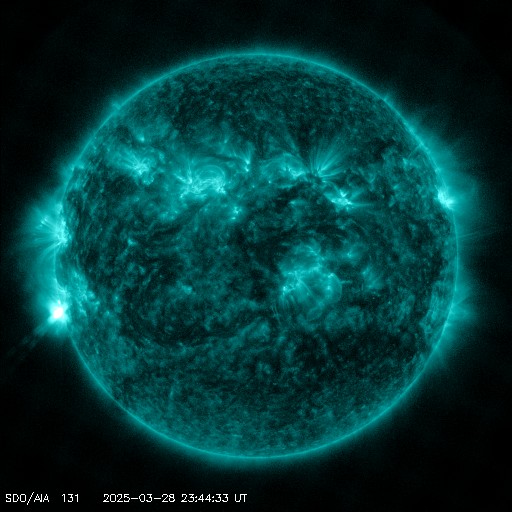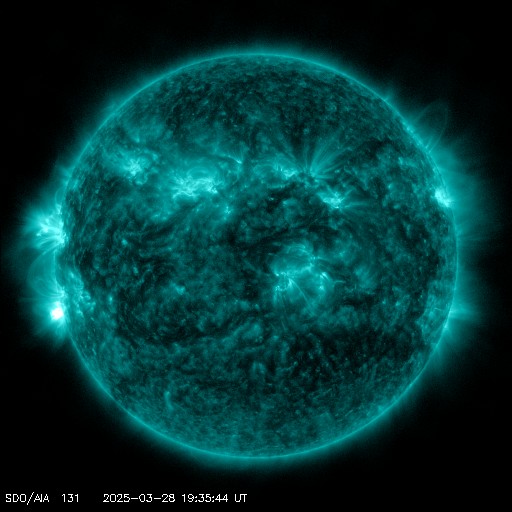Viewing archive of Friday, 17 August 2001
Solar activity report
Any mentioned solar flare in this report has a scaling factor applied by the Space Weather Prediction Center (SWPC). Because of the SWPC scaling factor, solar flares are reported as 42% smaller than for the science quality data. The scaling factor has been removed from our archived solar flare data to reflect the true physical units.
Report of Solar-Geophysical Activity 2001 Aug 17 2200 UTCPrepared by the NOAA © SWPC and processed by SpaceWeatherLive.com
Joint USAF/NOAA Report of Solar and Geophysical Activity
SDF Number 229 Issued at 2200Z on 17 Aug 2001IA. Analysis of Solar Active Regions and Activity from 16-2100Z to 17-2100Z
Solar activity was low. Only a few low-level C-class
subflares occurred. The largest was a C1/Sf at 17/0011 UTC in Region
9581 (S25W42). Although there are several sunspot groups on the
visible disk all of them are relatively small and magnetically
simple. New Regions 9586 (S15W47) and 9587 (S11E56) were numbered.
IB. Solar Activity Forecast
Solar activity is expected to be low.
Additional low-level C-class flares are possible.
IIA. Geophysical Activity Summary 16-2100Z to 17-2100Z
The geomagnetic field was quiet until the occurrence of a sudden
impulse observed at ground magnetometers (36 nT at Boulder) at about
17/1103 UTC. The impulse was preceded by a shock observed at the
NASA ACE spacecraft at 17/1017 UTC. The geomagnetic field has been
at mostly active to minor storm levels since the impulse. A series
of magnetopause crossings were observed at the NOAA GOES spacecraft
in the interval from about 17/1930--2100 UTC. The greater than 100
MeV proton event which began yesterday has ended (start 16/0105 UTC,
29 pfu peak at 16/0305 UTC, and end 17/1415 UTC). The greater than
10 MeV event remains in progress (start 16/0135 UTC and 493 pfu peak
at 16/0355 UTC). The current proton flux (17/2100 UTC) at greater
than 10 MeV is about 20 pfu and is slowly decaying.
IIB. Geophysical Activity Forecast
The geomagnetic field is
expected to be at mostly active to minor storm levels for the next
24 hours becoming unsettled to active after that. The greater than
10 MeV proton event is expected to end by 19 August.
III. Event Probabilities 18 Aug to 20 Aug
| Class M | 10% | 10% | 10% |
| Class X | 01% | 01% | 01% |
| Proton | 90% | 30% | 01% |
| PCAF | in progress | ||
IV. Penticton 10.7 cm Flux
Observed 17 Aug 145 Predicted 18 Aug-20 Aug 150/150/155 90 Day Mean 17 Aug 151
V. Geomagnetic A Indices
Observed Afr/Ap 16 Aug 003/008 Estimated Afr/Ap 17 Aug 025/025 Predicted Afr/Ap 18 Aug-20 Aug 020/015-015/015-010/018
VI. Geomagnetic Activity Probabilities 18 Aug to 20 Aug
| A. Middle Latitudes | |||
|---|---|---|---|
| Active | 30% | 20% | 15% |
| Minor storm | 15% | 05% | 05% |
| Major-severe storm | 05% | 01% | 01% |
| B. High Latitudes | |||
|---|---|---|---|
| Active | 40% | 30% | 20% |
| Minor storm | 20% | 10% | 05% |
| Major-severe storm | 05% | 01% | 01% |
All times in UTC
Current data suggests there is a slight possibility for aurora to appear at the following high latitude regions in the near future
UtsjokiKirkenes
Murmansk
Latest news
Latest forum messages
AR4048 2Incoming & Unnumbered Active Regions 1658Aurora photography hints for those of us with smartphones 51AR4046 127Large Coronal Hole 25 178
More topicsSupport SpaceWeatherLive.com!
A lot of people come to SpaceWeatherLive to follow the Sun's activity or if there is aurora to be seen, but with more traffic comes higher server costs. Consider a donation if you enjoy SpaceWeatherLive so we can keep the website online!

Latest alerts
00:00 UTC - Solar flare
Moderate M1.79 flare
Friday, 28 March 2025
23:36 UTC - Radio Blackout
Minor R1 radio blackout in progress (≥M1 - current: M1.04)
21:24 UTC - Hemispheric Power Index
The OVATION model predicts the Hemispheric Power Index to reach 51GW at 21:59 UTC
19:45 UTC - Solar flare
Moderate M1.16 flare
19:27 UTC - Radio Blackout
Minor R1 radio blackout in progress (≥M1 - current: M1.1)
Space weather facts
| Last X-flare | 2025/03/28 | X1.1 |
| Last M-flare | 2025/03/28 | M1.7 |
| Last geomagnetic storm | 2025/03/27 | Kp5 (G1) |
| Spotless days | |
|---|---|
| Last spotless day | 2022/06/08 |
| Monthly mean Sunspot Number | |
|---|---|
| February 2025 | 154.6 +17.6 |
| March 2025 | 128.3 -26.4 |
| Last 30 days | 128.3 -23.7 |




